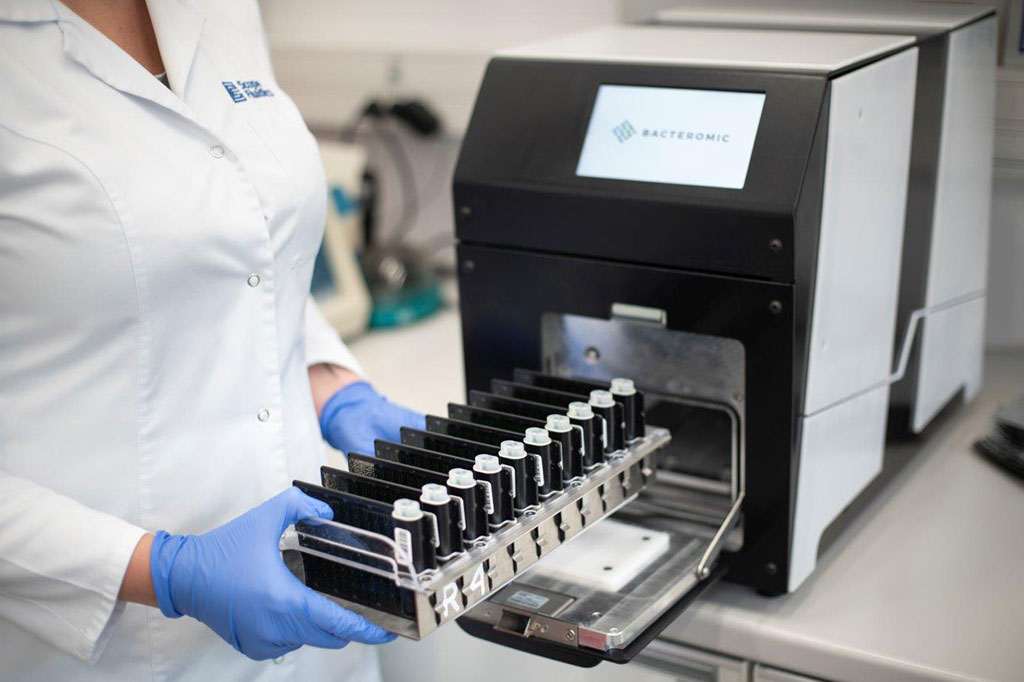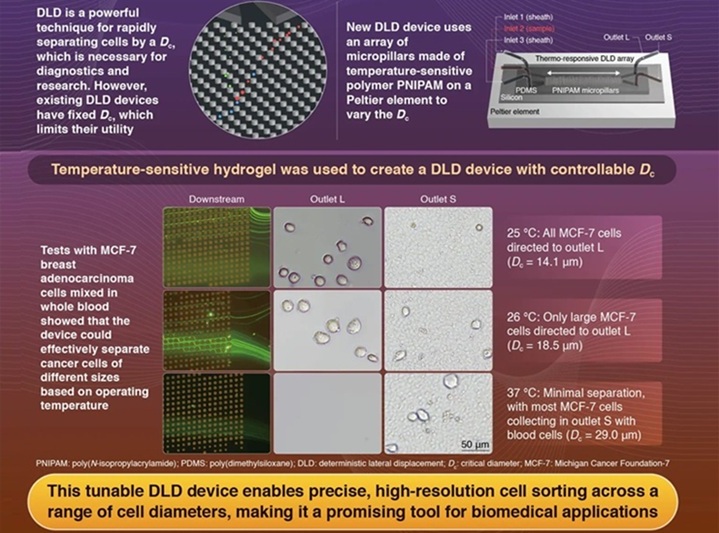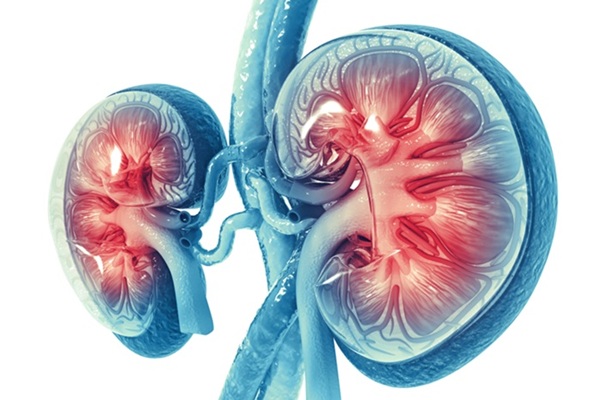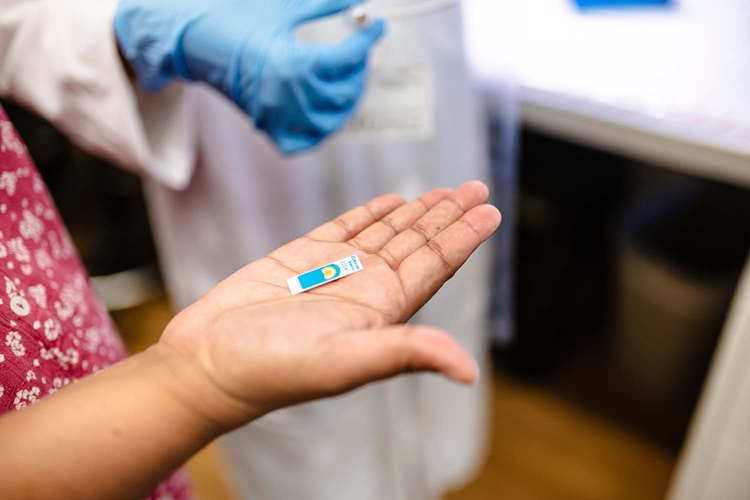Scope Fluidics’ Microfluidic Antimicrobial Susceptibility System Obtains European CE IVD Marking Approval
|
By LabMedica International staff writers Posted on 29 Oct 2021 |

Scope Fluidics’ (Warsaw, Poland) BacterOMIC microfluidic antimicrobial susceptibility system has received a European CE marking certificate for in vitro diagnostic devices, which approves it for use on the European Union market.
The BacterOMIC system allows for the identification in a single test of the effectiveness of a range of 20 antibiotics that are used in the treatment of, among others, infections of the respiratory tract, blood, urinary tract, or skin, caused by the Enterobacterales; Pseudomonas; Acinetobacter, Staphylococcus bacteria. The system makes it possible to assess the treatment effectiveness for the following antibiotics, all in one test: amoxicillin, cefuroxime, cefazolin, tobramycin, amikacin, azithromycin, ceftazidime, ceftazidime with avibactam, ciprofloxacin, clindamycin, ceftriaxone, cefotaxime, cefepime, moxifloxacin, norfloxacin, ofloxacin, piperacillin, piperacillin with tazobactam, trimethoprim, trimethoprim with sulfamethoxazole.
The modern diagnostic device has undergone clinical tests of the first diagnostic panel. The tests confirmed the functionality of the BacterOMIC system in diagnosing the drug susceptibility of bacteria causing a number of infections, including in the respiratory system, blood, urinary tract and skin. During specialized tests carried out in independent clinical centers, the system achieved over 90% compliance in the drug susceptibility assessment for 20 antibiotics which were assigned to one of the two resistance categories: resistant/susceptible. The company plans to expand the system with more antibiotics in order to make full use of the system’s diagnostic capabilities.
“BacterOMIC is a system with a very large market potential, which has a chance to revolutionize antibiotic treatment,” said Marcin Izydorzak, Vice President and one of the founders of Scope Fluidics. “Today, the needs of doctors and their patients in this area are enormous. Experts estimate that the market for automated antimicrobial susceptibility testing is worth approximately USD1 billion annually. Clinical tests have proven the efficiency of the BacterOMIC system, which ultimately might be able to test all clinically significant antibiotics in one test.”
“BacterOMIC is an exceptional solution on a world scale, and ultimately it is intended to allow us to check up to 640 bacteria cultivation conditions in one test,” added Dr. Seweryn Bajer-Borstyn, head of the BacterOMIC project in the Scope Fluidics Group. “This will translate into the possibility of creating a single test to cover most clinically used antibiotics. We are happy that our work on all the aspects of the system were confirmed in the clinical tests of the first BacterOMIC diagnostic panel.”
Related Links:
Scope Fluidics
Latest Microbiology News
- Rapid Diagnostic Test Matches Gold Standard for Sepsis Detection
- Rapid POC Tuberculosis Test Provides Results Within 15 Minutes
- Rapid Assay Identifies Bloodstream Infection Pathogens Directly from Patient Samples
- Blood-Based Molecular Signatures to Enable Rapid EPTB Diagnosis
- 15-Minute Blood Test Diagnoses Life-Threatening Infections in Children
- High-Throughput Enteric Panels Detect Multiple GI Bacterial Infections from Single Stool Swab Sample
- Fast Noninvasive Bedside Test Uses Sugar Fingerprint to Detect Fungal Infections
- Rapid Sepsis Diagnostic Device to Enable Personalized Critical Care for ICU Patients
- Microfluidic Platform Assesses Neutrophil Function in Sepsis Patients
- New Diagnostic Method Confirms Sepsis Infections Earlier
- New Markers Could Predict Risk of Severe Chlamydia Infection
- Portable Spectroscopy Rapidly and Noninvasively Detects Bacterial Species in Vaginal Fluid
- CRISPR-Based Saliva Test Detects Tuberculosis Directly from Sputum
- Urine-Based Assay Diagnoses Common Lung Infection in Immunocompromised People
- Saliva Test Detects Implant-Related Microbial Risks
- New Platform Leverages AI and Quantum Computing to Predict Salmonella Antimicrobial Resistance
Channels
Clinical Chemistry
view channel
Chemical Imaging Probe Could Track and Treat Prostate Cancer
Prostate cancer remains a leading cause of illness and death among men, with many patients eventually developing resistance to standard hormone-blocking therapies. These drugs often lose effectiveness... Read more
Mismatch Between Two Common Kidney Function Tests Indicates Serious Health Problems
Creatinine has long been the standard for measuring kidney filtration, while cystatin C — a protein produced by all human cells — has been recommended as a complementary marker because it is influenced... Read moreMolecular Diagnostics
view channel
Simple Urine Test to Revolutionize Bladder Cancer Diagnosis and Treatment
Bladder cancer is one of the most common and deadly urological cancers and is marked by a high rate of recurrence. Diagnosis and follow-up still rely heavily on invasive cystoscopy or urine cytology, which... Read more
Blood Test to Enable Earlier and Simpler Detection of Liver Fibrosis
Persistent liver damage caused by alcohol misuse or viral infections can trigger liver fibrosis, a condition in which healthy tissue is gradually replaced by collagen fibers. Even after successful treatment... Read moreHematology
view channel
Platelet Activity Blood Test in Middle Age Could Identify Early Alzheimer’s Risk
Early detection of Alzheimer’s disease remains one of the biggest unmet needs in neurology, particularly because the biological changes underlying the disorder begin decades before memory symptoms appear.... Read more
Microvesicles Measurement Could Detect Vascular Injury in Sickle Cell Disease Patients
Assessing disease severity in sickle cell disease (SCD) remains challenging, especially when trying to predict hemolysis, vascular injury, and risk of complications such as vaso-occlusive crises.... Read more
ADLM’s New Coagulation Testing Guidance to Improve Care for Patients on Blood Thinners
Direct oral anticoagulants (DOACs) are one of the most common types of blood thinners. Patients take them to prevent a host of complications that could arise from blood clotting, including stroke, deep... Read moreImmunology
view channel
New Test Distinguishes Vaccine-Induced False Positives from Active HIV Infection
Since HIV was identified in 1983, more than 91 million people have contracted the virus, and over 44 million have died from related causes. Today, nearly 40 million individuals worldwide live with HIV-1,... Read more
Gene Signature Test Predicts Response to Key Breast Cancer Treatment
DK4/6 inhibitors paired with hormone therapy have become a cornerstone treatment for advanced HR+/HER2– breast cancer, slowing tumor growth by blocking key proteins that drive cell division.... Read more
Chip Captures Cancer Cells from Blood to Help Select Right Breast Cancer Treatment
Ductal carcinoma in situ (DCIS) accounts for about a quarter of all breast cancer cases and generally carries a good prognosis. This non-invasive form of the disease may or may not become life-threatening.... Read morePathology
view channel
Tunable Cell-Sorting Device Holds Potential for Multiple Biomedical Applications
Isolating rare cancer cells from blood is essential for diagnosing metastasis and guiding treatment decisions, but remains technically challenging. Many existing techniques struggle to balance accuracy,... Read moreAI Tool Outperforms Doctors in Spotting Blood Cell Abnormalities
Diagnosing blood disorders depends on recognizing subtle abnormalities in cell size, shape, and structure, yet this process is slow, subjective, and requires years of expert training. Even specialists... Read moreTechnology
view channel
Artificial Intelligence Model Could Accelerate Rare Disease Diagnosis
Identifying which genetic variants actually cause disease remains one of the biggest challenges in genomic medicine. Each person carries tens of thousands of DNA changes, yet only a few meaningfully alter... Read more
AI Saliva Sensor Enables Early Detection of Head and Neck Cancer
Early detection of head and neck cancer remains difficult because the disease produces few or no symptoms in its earliest stages, and lesions often lie deep within the head or neck, where biopsy or endoscopy... Read moreIndustry
view channel
Abbott Acquires Cancer-Screening Company Exact Sciences
Abbott (Abbott Park, IL, USA) has entered into a definitive agreement to acquire Exact Sciences (Madison, WI, USA), enabling it to enter and lead in fast-growing cancer diagnostics segments.... Read more




 assay.jpg)



 (3) (1).png)














